NVIDIA Shield Review: At the Crossroads of PC and Mobile Gaming
by Brian Klug on July 31, 2013 12:14 AM ESTGFXBench 2.7.0
While GFXBench 2.7 (formerly GLBenchmark 2.7) doesn't yet take advantage of OpenGL ES 3.0 (GLB 3.0 will deliver that), it does significantly update the tests to recalibrate performance given the advances in modern hardware. Version 2.7 ditches classic, keeps Egypt HD and adds a new test, T-Rex HD, featuring a dinosaur in pursuit of a girl on a dirt bike.
Scene complexity goes up tremendously with the T-Rex HD benchmark. GLBenchmark has historically been more computationally bound than limited by memory bandwidth. The transition to T-Rex HD as the new flagship test continues the trend. While we see scaling in average geometry complexity, depth complexity and average memory bandwidth requirements, it's really in the shader instruction count that we see the biggest increase in complexity.

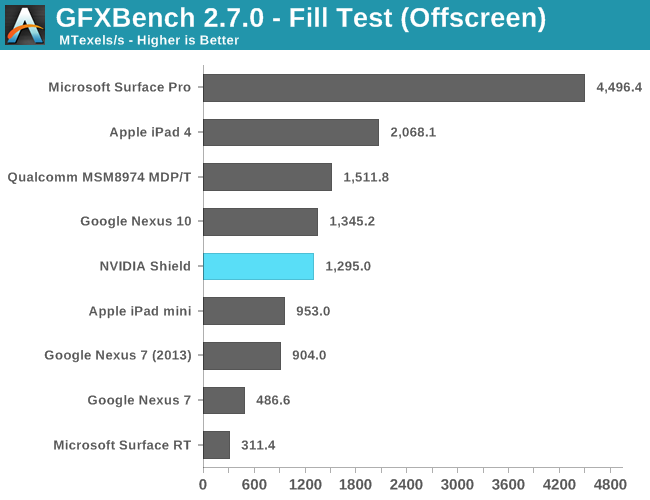
The fill rate tests put Shield significantly behind the iPad 4 and about on par with the Nexus 10. Looking at Triangle throughput we see Apple hold onto an advantage there as well, although Tegra 4 does show impressive gains over Tegra 3.
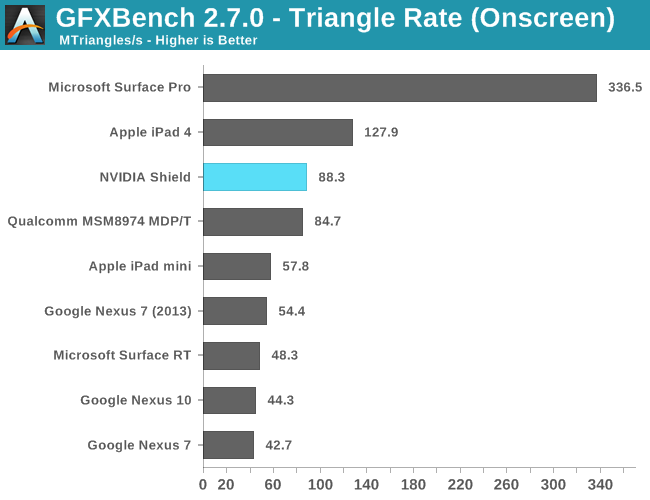
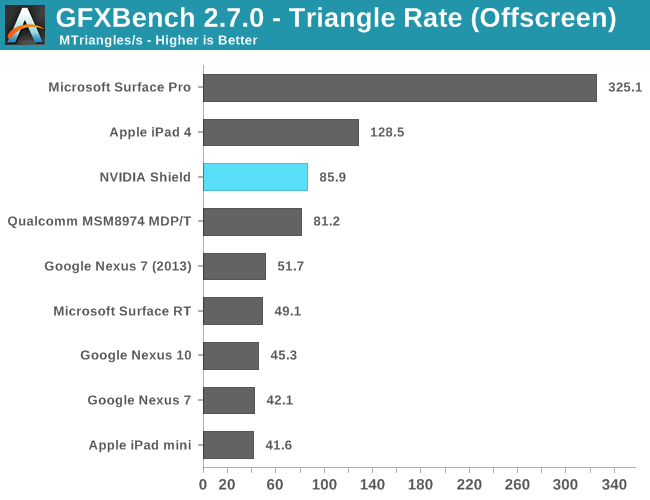
It's really in the pixel shader bound tests that Tegra 4 really excels:
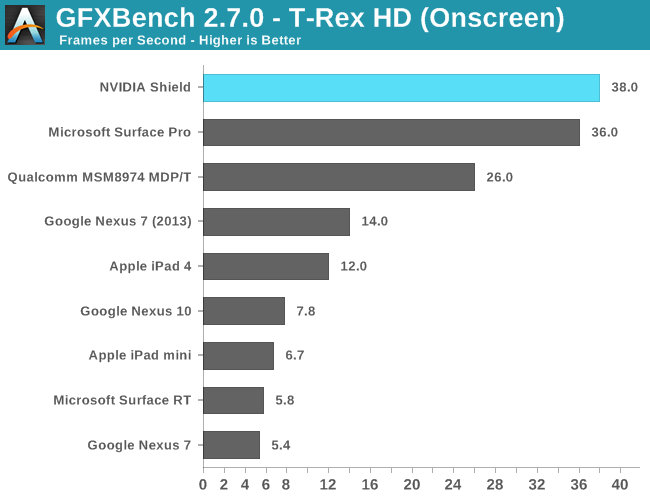
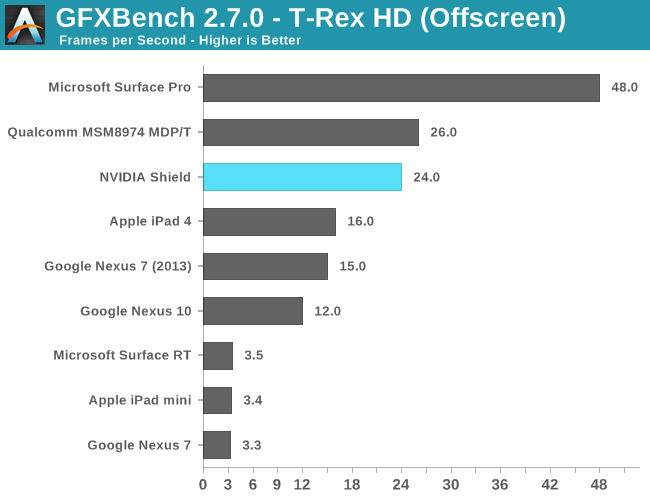
As promised, Tegra 4's GPU manages to outperform the iPad 4's PowerVR SGX 554MP4 in GFXBench 2.7. The 50% performance advantage is appreciable, and should be very nice on a high res display. It's a shame Shield is stuck with a 720p panel. Note that we're also half way to the performance of Intel's HD 4000 here. The Adreno 330 comparison is, once again, extremely close. Qualcomm pulls ahead by 8% and that's without a fan in a tablet chassis.
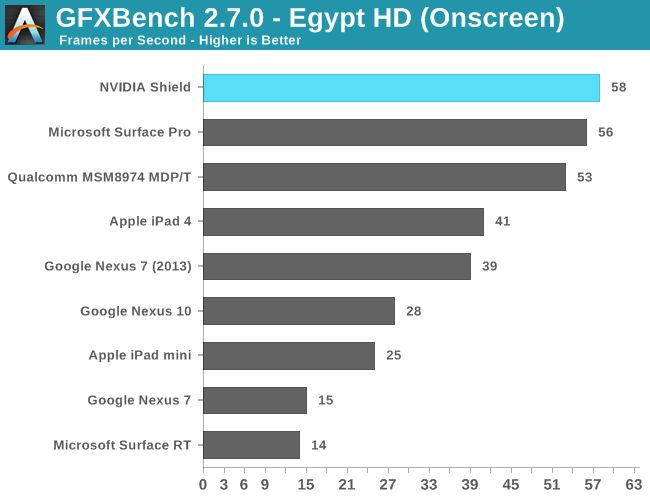
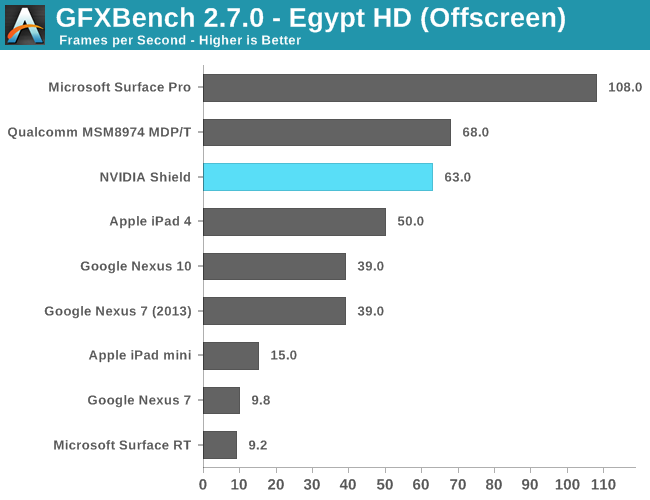










134 Comments
View All Comments
chizow - Wednesday, July 31, 2013 - link
Thanks, I'll have to keep an eye out for some info from users/reviews about streaming functionality. I was specifically interested in Windows Media Extender functionality to playback encrypted/premium cable TV from a cable card tuner, and it looks like XBMC may do the trick. Just not sure if the Android version supports this, or if the Android version of XBMC runs on Shield (it should since it's full Android 4.2.1).This video indicates it may be possible to stream cable card content to XBMC, but it looks like Windows version: http://www.youtube.com/watch?v=0aFTl3wYf04
SlitheryDee - Wednesday, July 31, 2013 - link
I'm pretty intrigued by this product. With the delay of tegra 4 and the presence of cheaper dedicated gaming systems with far more titles available to them, I have to think that this iteration was focused on ironing out the bugs in the design rather than setting the world on fire with sales. Just getting it out there, making people aware of it, and starting up the development of a decent number of games with the shield in mind would have to be enough to call the first run a success IMO. I don't know how Nvidia could have expected any more than that when thrusting a gamepad oriented android device into a touch-centric game world. I like that it was well executed, and I hope they go ahead with the next version with a (hopefully on time) tegra 5.et20 - Wednesday, July 31, 2013 - link
Thanks for the review.It's a really nice surprise to see nvidia deliver such a well balanced and put together product.
Let's hope that it will spur availability of high quality games.
Hrel - Wednesday, July 31, 2013 - link
Frankly this is a nice little device that does a lot of things right. Perhaps I'll pick one up when they do a revision featuring Nvidia's newest mobile GPU. That is of course the downside to devices this integrated (mobile); no upgrade ability. Upgrade ability is really the primary thing that I think is stopping gaming from moving to mobile devices for real. Once the product cycles slow down, which they're already doing, we should see mobile gaming really start to catch on and devices like this actually start to sell well.For now, no 802.11ac = not even the POSSIBILITY of me purchasing.
dbx81 - Wednesday, July 31, 2013 - link
shield + chromecast seems like a good combo right away, doesn't it?rwei - Wednesday, July 31, 2013 - link
I'd rather have a SwitchbladeSuvorov Sulla - Wednesday, July 31, 2013 - link
I know Brian can't do it because he is writting an official review and all that jazz but I REALLY wanted to see someone using a SNES and a PSP emulator on this thing. I would be honestly interested if it works well.thesavvymage - Wednesday, July 31, 2013 - link
I cant speak for PSP as I've never tried it, but snes emulation with a ps3 controller works flawlessly on my Nexus 4. This thing is more powerful in every way, so it should be pretty amazing.nafhan - Wednesday, July 31, 2013 - link
So... I'd be really interested in seeing a "battery life while streaming a PC game" test. I'm guessing something like the web browsing battery life -30%.Actually, a streaming video playback test might be interesting to see in general.
cmikeh2 - Wednesday, July 31, 2013 - link
I think it will be well above that. With the web browsing test there's a lot of CPU activity but when doing the remote PC gaming all it is doing is play an H.264 video from the network. I see it as pretty much in the middle of the web browsing test and the H.264 test.